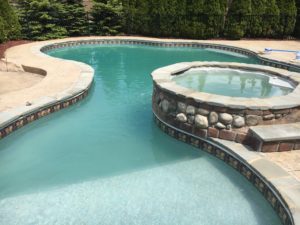
The intellichlor Salt Cell has a lifetime of approx 10,000 hours. To check this, press and hold the more button for 3 seconds. The lights should scroll through and leave a few of the percentage lights lit up. The amount of lights corresponds to the amount of life used. If the first three lights are lit (20, 40, and 60%) then you’ve used 6,000 hours of the expected 10,000. When your cell approaches the end, it won’t work like it is supposed to and your pool may start to discolor. Be proactive and call for service so your pool team can assess the cell and determine if it just needs a cleaning, or if it is time to swap it out.

We knew it was time when this pool started to look not so blue and sparkly…
The Math:
Assuming a cell is good for 10,000 hours, and we’ll approximate a five year lifetime, that’s about 2,000 hours per year.
Like any pool owner who wants really clean water, with a fully optimized system and perhaps a variable speed pump, we’ll run the system:
24 hours a day x 7 days a week = 168 hours/week
which means we’ll expect just under 12 weeks of use per year (3 months).
If you’re a super fun pool owner who opens April 1 and Closes Nov 1, give or take, that’s 6 months of use, meaning we’ve shortened our cell lifetime to 2.5 years.
More Math:
Since we want to fully sanitize our pool and run the system as it was optimally designed for bather comfort/pool sanitizing and all that, we’re going to look at this another way:
Turn the pool on, run 24 hours a day, 7 days a week, for about 6 months of our amazing spring/summer/fall here in Michigan and have swimming ready water at all times! That will give us
24 hours x 7 days = 168 hours of use per week
168 hours/week x 4 weeks/month = 672 hours per month = 4032 hours for the season – so your salt cell would be expected to last 2.5 years.
If you’re water is hard water, contains minerals, or you let your pH/alkalinity drift up and you have scaling on the plates, you’ll need to do an acid bath. It’s important not to do too many since that can shorten the life of the cell. It will be necessary to do it however, so do so with care. Also – if a screwdriver or any item is inserted into the cell to “help” remove the scale – likely you’re buying a new one. So don’t do that.
Chlorine Doses
It’s important to carry a 1-3ppm residual of chlorine in a swimming pool at all times, plus a super sanitize/shock/oxidize once a week to help reset any combined chlorine and allow as much chlorine activated as possible to do it’s dirty work.
If you were dosing with liquid chlorine, depending on the size of your pool that would mean dumping in liquid chlorine every day (you can do this, but it’s the most tedious way of chlorinating your pool.) Liquid chlorine is the most “unstable” form, meaning as soon as sunlight hits your water, poof, the chlorine molecule is gone, and no cleaning/sanitizing power remains.
How do you calculate chlorine?
It can be calculated by converting the grams per liter available in chlorine into its equivalent as sodium hypochlorite by multiplying the ratio of their respective molecular weights: Grams Per Liter Available in Chlorine x NaOCl/Cl2 or x 74/71 or 1.05 = Grams Per Liter Sodium Hypochlorite.
What if there is algae in the water?
It’s a generally accepted notion that 30 ppm of chlorine residual will kill all algae.
How much chlorine do I need to shock my pool?
Liquid chlorine is sodium hypochlorite (a chlorine compound) dissolved in a solution of water. Because it is dissolved in water it typically has a 12½% active content.This means by using liquid chlorine it goes to work the second it is poured in your pool. It’s also super affected by the sun – poof! though that’s it’s super power too since it treats algae the way the sun treats it.
Chlorine Residuals
Residential pools should maintain a 1-3ppm chlorine residual.
Guidelines for commercial pools can be higher because of a higher bather load – there are a lot more factors as well, but let’s assume they should be at 3-5ppm for this example.
Commercial pools should run their chlorine levels at 3 -5 ppm as their bather load is usually much higher. Anything between 5-10 ppm is still safe to swim, but you are risking damage to equipment and certainly complaints from swimmers. Some experts recommend no swimming unless the chlorine is 8 ppm or less.
add 0.00013 ounces per gallon to raise the chlorine by 1 ppm
Clorox (or household bleach) – what’s the difference?
Sometimes homeowners not knowing the difference will use household bleach in a swimming pool – often a smaller above ground version – and sometimes in smaller amounts of water this is okay. Household bleach is typically a 5% solution of the available chlorine, and pool chlorine comes in 10%-15% concentrations.
Tablets (tri-chlor) are 90% chlorine, though slow dissolving, and often stabilized with cya as well.
Liquid chlorine get’s your levls up quickly – but you need to add more often to keep levls up.
Tablets get your levels up slowly – because they are slow dissolving.
Chlorine Comparisons
| PRODUCT | AVAILABLE CHLORINE | pH |
| Household Bleach | 5% | 13 |
| Pool Liquid Chlorine | 12%-15% | 13 |
| Lithium Hypochlorite | 30%-35% | 11 |
| Bromine | 54% | 4.5 |
| Sodium Dichlor | 55% | 7(neutral) |
| Calcium Hypochlorite (Cal-Hypo) | 65%-75% | 11.7 |
| Trichloro-S-Triazinetrione (Tri-Chlor 3″ tabs) | 90% | 3 |
